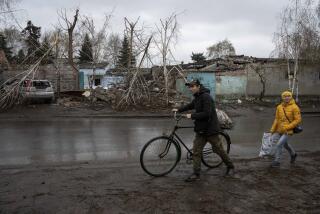War on the World Wide Web : The Internet allows us to be inundated with minutiae on Bosnia. But do thousands of facts equal understanding?
Welcome to BosniaLINK, the official Department of Defense information system about U.S. military activities in Operation Joint Endeavor, the NATO peacekeeping mission to Bosnia. Would you like to know what cold-weather gear soldiers are wearing? How about a biography of Brig. Gen. Stanley F. Cherrie? Interested in sending a message to the troops? All this and more can be yours from the military’s latest Internet home page. Just dial
CNN brought the Persian Gulf War into the living room, but this is somehow different: less dramatic, more intellectually stimulating. The information, not having been filtered through reporters, must be more accurate. Statistics, troop deployments, fact sheets. Cruising this site makes me feel thoroughly well-informed. And completely disoriented.
Such information has always been there. These electronic postings are the same documents the Pentagon hands out to reporters or anyone else who requests them. I have never requested anything from the Pentagon, yet here I sit, pulling up page after page from BosniaLINK, printing them out (we latecomers to the medium still like the feel of paper). I read the State Department summary of the Dayton peace agreement, scan long lists of mobilized Army National Guard and Reserve units, learn that imminent-danger pay is $150 per month and that it applies to the airspace above Bosnia but not to nearby coastal waters.
At my fingertips are all the facts a laptop strategist could desire. Visitors to the site can choose from a menu of options, much as they can at the MTV web site; maps and charts, fact sheets, news releases, photos, biographies of key commanders and leaders, transcripts and briefings, speeches and testimony. A single click of the mouse can connect a surfer to related sites such as Air Force Role in Bosnia, America’s Army in Bosnia, White House, NATO, Navy News Service: Bosnia Operations, U.S. State Department: U.S. Policy on Bosnia. The well of information seems bottomless. I doubt, however, whether knowing the names of Cherrie’s children (Bryan, Victoria and Jennifer) adds much to my understanding of events. Or whether complete transcripts of press briefings leave me any more knowledgeable about Bosnia. With so much data available, I am overwhelmed by drivel.
What is missing from BosniaLINK is context. In the past, we trusted politicians, journalists, generals and historians to sift through the facts and present us with a coherent story. Their versions often offered contradictory scenarios, but the information was always framed by narrative. They took data and wove them into context, at worst a warped or self-serving version of events, at best an honest interpretation. What I found on BosniaLINK were free-floating casts of characters, descriptions of settings, lists of props. It was a novel that had been reformatted as a series of lists: Prince Andre, Pierre, Napoleon, Battle of Borodino, St. Petersburg, winter cold, chilblains. Tolstoy would not be amused. With no plot line, I could not construct a sensible version of the truth in Bosnia.
Perhaps what bothered me most was the invitation to send greetings to “any soldier” in Bosnia. Obviously, messages could not be delivered to specific individuals or units. A selection was distributed through internal military print media and broadcast over Armed Forces Radio and Television. To send a message, one had only to access Defense BosniaLINK, fill out the form provided and click on the “send message” button.
Messages to “any soldier?” Information masquerading as insight? Like Miranda in “The Tempest,” I cannot help but cry, “O brave new world, that has such people in’t.” O brave new world, when data displace story.
More to Read
Sign up for Essential California
The most important California stories and recommendations in your inbox every morning.
You may occasionally receive promotional content from the Los Angeles Times.









